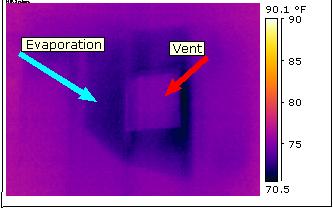Info Submitted By:
Joel Nachman
FLIR certified Level 1
FLIR certified Building Science
ITC- BSI
President Longwave Inspection Services LLC
P.O. Box 434
Stevenson, Maryland 21153.
Tel. 410-654-8454
Condensation in wall cavity
This is a very interesting issue that had taken place in the Maryland area. Several contractors tried to diagnose the problem but were unsuccessful.
Thermography: Building Science
Location: Maryland
Found Issue: Condensation due to building defect.
Age of home: 9 years
Style of home: 8,000 sq foot split level with full basement.
Original issue: Homeowner was having a problem with ceramic tiles cracking and lifting in a bay window area. There was also a sign of old water staining on the finished ceiling of the basement below.
Original Contractor's Diagnoses:
1. Windows should be caulked possible leaking.
Windows should be caulked possible leaking.
2. Flashing installed incorrectly over bay hip roof.
Flashing installed incorrectly over bay hip roof.
3. Poor drainage on the pad adjacent to the bay window.
Poor drainage on the pad adjacent to the bay window.
4. Possible plumbing leak.
Possible plumbing leak.
5. Siding around bay window should be replaced.
Siding around bay window should be replaced.
6. Flashing around the bottom of the bay window should be replaced.
Flashing around the bottom of the bay window should be replaced.
These were actual diagnoses given to the homeowner from six separate contractors. None of them were 100% accurate.
This Is What Was Found Using Thermal Imaging:
The concrete pad located adjacent to the bay window was pored to high, it was level with the top of the foundation just below the mudsill. The rim joist was slightly cantilevered over the foundation. There was approximately 12" of crushed rock under the pad storing the moisture and allowing evaporation. The humidity built-up under the pad was migrating into the basement wall cavity to the cooler basement. This only took place in the hot summer months. Steam was causing the above sub-floor to rot. The Insulation was not 100% effective due to vapor pressure building up under the pad, this was caused because the pad was raised and encapsulated on all four sides by a brick retaining wall.
Before any repairs were made, a vent was installed between the studs in the basement. This allowed the moisture to cool and made the thermal anomaly stand out.
Unfortunately for the client, the findings of the evaluation were not pleasant. The issue was so severe that I shared my findings with two other thermographers and a structural engineer. They both concurred with my findings. There were some serious structural issues.
Outcome:
The entire concrete pad needs to be broken-up. The grade needs to be lowered so that the new pad falls no less than 8" below the top of the foundation. Install trench drains at the end of the pad. Install vents in the surrounding retaining wall. The area of exterior foundation below the bay window needs to be insulated and than refinished. A part of the sub-floor will need to be replaced due to 8 years of rotting. The area in the basement under the bay needs to be rebuilt.
The basement wall has been removed and is in bad shape. The amazing thing is that there was very little visible damage. Infrared was the only way this would have been detected. Eventually the kitchen floor and bay would have collapsed causing a much more serious problem.
Price to fix was contracted at $15,000.00 for the new pad, sub-floor, new tiles in the small kitchen area, finish exterior foundation and sheet rock the wall in basement.
What We Are Trying To Accomplish By The Reconstruction Is:
1. Use gravity and good building techniques to keep the water from getting under the pad.
2. Any moisture that does get under the pad would have an escape route and evaporate to the outside, not into the home.
3. Insulate the foundation to keep the moist warm air from trying to migrate to the cooler basement in the summer months.



